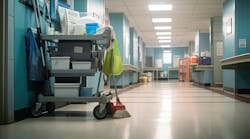Most schools and universities begin their new year during August and September. This creates a terrific opportunity to orient students to what they should expect and what is expected of them. In many instances this orientation is focused on helping students navigate facilities and campuses, and learn about academic requirements, codes of conduct, food and health services, busing and parking, and if applicable, residential life, athletics, arts and extracurricular activities.
But the beginning of the school year also is an opportunity to orient students on creating a clean, safe, healthful and high-performing facility, which reduces impacts on the environment. After all, students will know what is expected of them only if they are told.
Communicating what is expected of students need not be complicated or time-consuming. Most suppliers of cleaning products and services offer posters, signage and other materials that can help. Don’t be afraid to ask suppliers to customize their materials with school logos, mottos and mascots to make the program an even better fit.
Some opportunities to consider:
• Main entrances. Because this is the place that creates a first impression, hang a poster announcing the school’s commitment to green cleaning and a healthful school environment. This is an especially good location to publicize goals in regard to recycling, green cleaning, healthful foods, food waste, and energy and water conservation. And clearly state “we can’t do it without you” (or something similar) to get buy-in.
• Restrooms. Explain the importance of hand hygiene and the appropriate way to wash hands. Other opportunities for signage can address the use of “green” janitorial paper, hand soaps, cleaning chemicals, equipment, microfiber and other products. Also consider including “numbers” such as how many trees are saved when using recycled paper, or the value of “on-site” generated cleaning chemicals, which can help make the connection to environmental benefits. Additionally, consider posting information on whom to call in the event of a problem such as a leaking faucet, along with a relevant “tip” that can make the poster resonate. The EPA and numerous other websites offer good tips, such as, “Leaky faucets that drip at the rate of one drip per second can waste more than 3,000 gallons of water each year.”
• Classrooms. Remind students to pick up after themselves. Signage can address picking up crayons, crafts and other supplies in a kindergarten class or how to properly dispose of or recycle beverage containers and paper in a lecture hall. Similarly, get kids to stack their own chairs and reposition furniture, which will result in more time for custodians to effectively clean.
• Recycling, composting and waste management. Success with these programs directly relates to education. Develop signage using specific images of what goes in each container. This will make it clear what can be recycled and where materials belong. Clear signage has a direct impact on student participation and the success of the overall program. Local waste haulers and recyclers typically can help with this information, as can distributors of recycling bins and plastic can liners.
• Cafeterias and dining halls. One of the largest environmental impacts comes from food service operations. Thus, this is an important place to communicate about healthful foods, food waste, recycling, composting and similar issues. Reducing food waste is a terrific way to reduce environmental impacts and save money!
Have a great school year!


